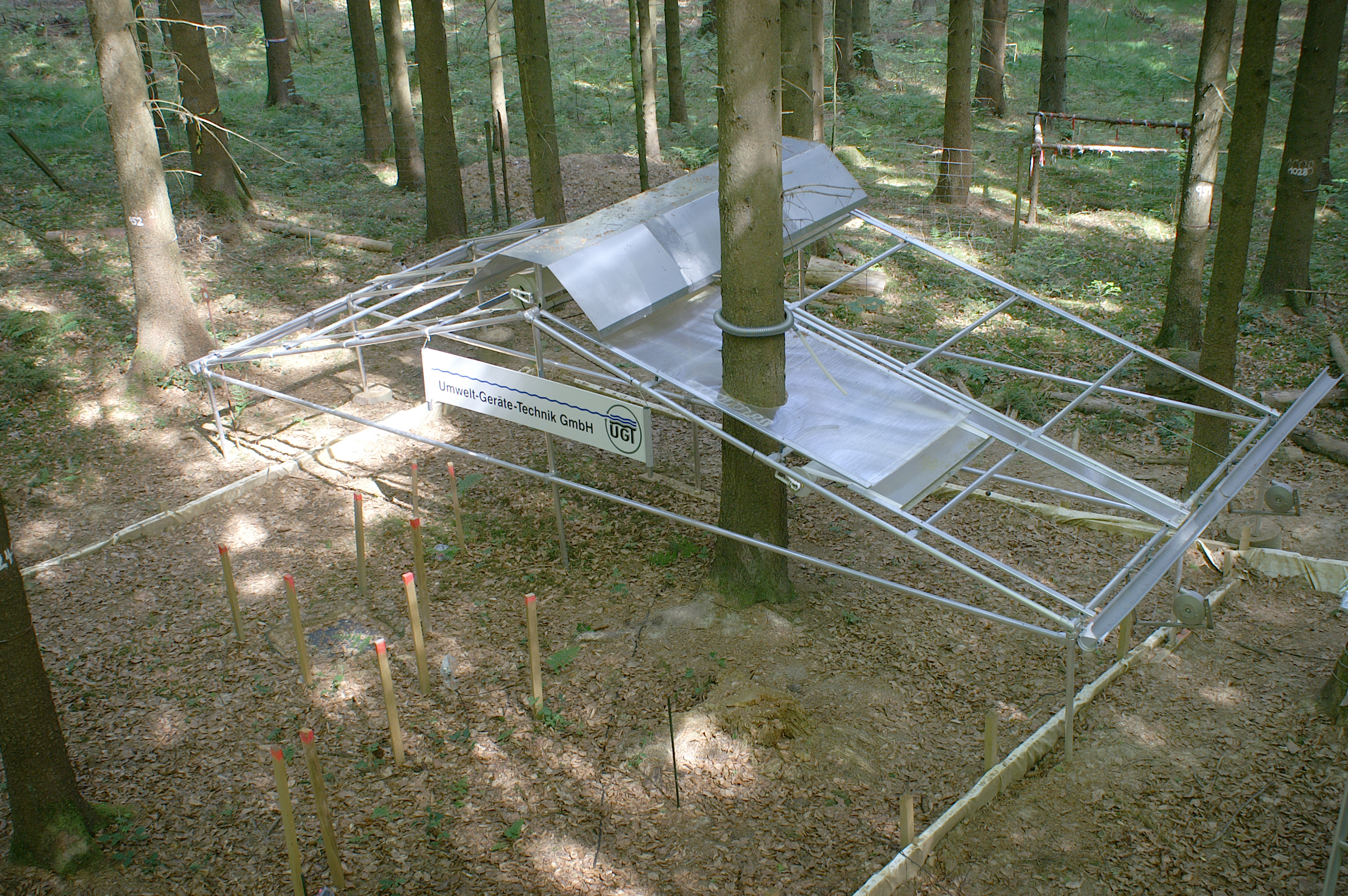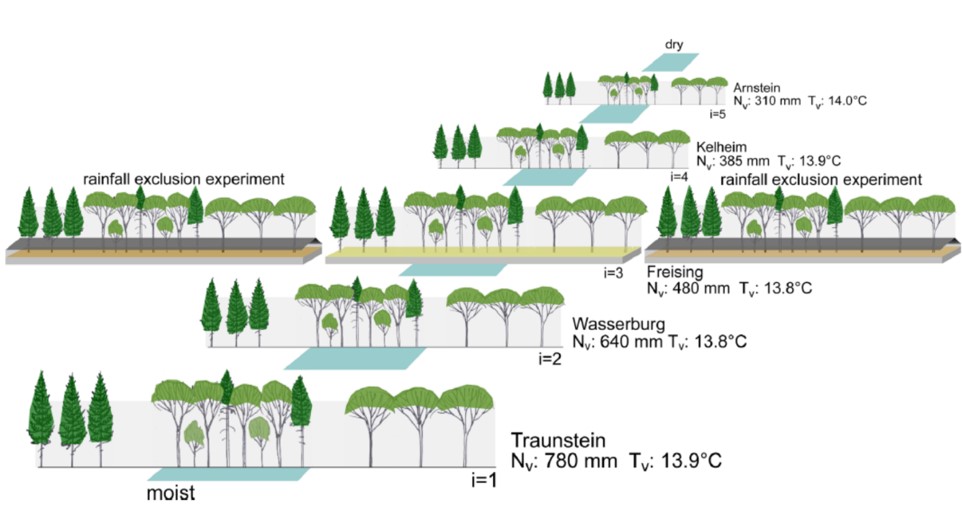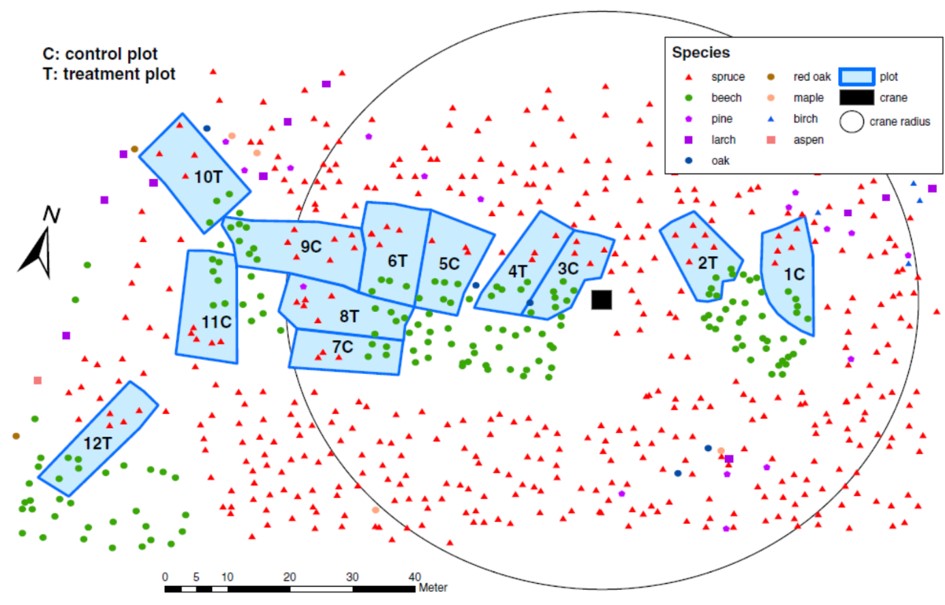Introduction
Background: Variability in precipitation is expected to increase with climate change across Central Europe (IPCC 2012), with potentially severe consequences for forest ecosystems (Breda, Huc et al. 2006; McDowell, Pockman et al. 2008; Allen, Macalady et al. 2010). Understanding processes towards biotic interactions that foster tree performance under severe stress is crucial for developing forest management practices.
Beech and spruce are species of concern (Scherer-Lorenzen, Körner et al. 2005; Metz, Annighöfer et al. 2016), doubted to withstand drought under climate change (Geßler, Keitel et al. 2007) but being crucial in Central Europe in ecological and economical terms (Ellenberg and Leuschner 2010). Both species have differential stomatal responsiveness to drought.
KROOF project phase 1 was initiated to explore the growth potential of European beech (Fagus sylvatica) and Norway spruce (Picea abies) in mixture relative to monocultures under exacerbating summer drought, as predicted for upcoming climate change in Central Europe (Allen, Breshears et al. 2015),. The KROOF approach based on experimental throughfall exclusion (TEE) at Kranzberg Forest with novel, rain-controlled roof closure (Fig. 1) and on five study sites of a precipitation gradient (PGR) across Bavaria, with triplets of beech-spruce mixtures and monocultures (Pretzsch, Rötzer et al. 2014). One overarching hypothesis was:
Hypothesis:
Drought stress limits the water consumption of Norway spruce more severely than that of European beech, so that the latter benefits from water re-partitioning in mixture.
 Fig. 1 Experimental throughfall exclusion (TEE) at Kranzberg Forest with novel, rain-controlled roof closure (Umwelt-Geräte-Technik GmbH, Germany)
Fig. 1 Experimental throughfall exclusion (TEE) at Kranzberg Forest with novel, rain-controlled roof closure (Umwelt-Geräte-Technik GmbH, Germany)
Material and Methods
The experimental plot Kranzberger Forst with a size of 0.5 ha is located at 11°39’42”E, 48°25’12”N, in the southern part of Bavaria, approximately 35 km northeast of Munich. The annual rainfall is around 750-800 l m-2 on average, the mean annual temperature is around 7.5 °C.
At the Kransberger site 12 plots were installed, with six plots representing the non-roofed control (C), and another six the treatment plots with roof-induced drought (Umwelt-Geräte-Technik GmbH, Germany; Fig. 2 and 3). The novelty of the roof construction is the automated closure during rain by means of water impermeable, tile-composed roller blinds, which are electrically motorized, while the roof-intercepted water amounts are channeled out of the study site (Fig. 1). At the experimental site are installations in each catchment of soil moisture, soil temperature and electrical conductivity sensors (UMP1, Umwelt-Geräte-Technik GmbH, Germany) for soil moisture assessment. Besides basic stemflow measurements (stemflow meter, Umwelt-Geräte-Technik GmbH, Germany) measurements of sap flow (HFD and SFM1 sap flow sensors, Umwelt-Geräte-Technik GmbH, Germany) and of waterpotential (stem psychrometer PSY, Umwelt-Geräte-Technik GmbH, Germany) were done.
 Fig. 2 The KROOF project: transect setup comprising a series of triples (pure spruce, pure beech, mixed spruce/beech stands) as located along a precipitation gradient from moist to dry sites across Bavaria (SE-Germany) combined with a controlled rainfall exclusion experiment on one site in the centre of the gradient with mediumwater supply (NV: average (1971–2000) precipitation of the growingseason, TV: average (1971–2000) temperature of the growing season); (Pretzsch, Rötzer et al. 2014)
Fig. 2 The KROOF project: transect setup comprising a series of triples (pure spruce, pure beech, mixed spruce/beech stands) as located along a precipitation gradient from moist to dry sites across Bavaria (SE-Germany) combined with a controlled rainfall exclusion experiment on one site in the centre of the gradient with mediumwater supply (NV: average (1971–2000) precipitation of the growingseason, TV: average (1971–2000) temperature of the growing season); (Pretzsch, Rötzer et al. 2014)
 Fig. 3 Map of the plots of the controlled rainfall exclusion experiment within Kranzberg Forest; (Pretzsch, Rötzer et al. 2014)
Fig. 3 Map of the plots of the controlled rainfall exclusion experiment within Kranzberg Forest; (Pretzsch, Rötzer et al. 2014)
Results and Conclusion
General achievements of project phase 1: Throughfall exclusion (TE) was conducted from mid-March through mid-December in 2014, 2015 and 2016, nearly depleting the plant-available soil water (depletion of TE >> control and in spruce > beech). When adjacent to beech, spruce’s fine-root production and water uptake shifted towards shallow soil horizons prone to drought (Goisser, Geppert et al. 2016). Overall, lowered fine root production and ramification resulted in decreased soil exploitation in spruce when growing together with beech. Ectomycorrhizal (ECM) community composition was changed and number of vital mycorrhizae was similarly reduced by drought in spruce and beech. Species mixture hardly counteracted drought. Total EA per soil volume strongly decreased due to the decline of vital fine roots. Spruce distinctly decreased stomatal conductance under drought, along with sap flow and net CO2 uptake rate. Phloem transport velocity in beech was not impeded by drought. Spruce distinctly reduced stem diameter growth under drought, particularly on moist sites. Drought-related increment variations between trees in pure and mixed stands were higher in beech than spruce.
Conclusion: Group-wise beech/spruce mixture is concluded as the favorable silvicultural option in anticipating climate change (Goisser, Geppert et al. 2016).
For more details please see:
http://kroof.wzw.tum.de/index.php?id=2